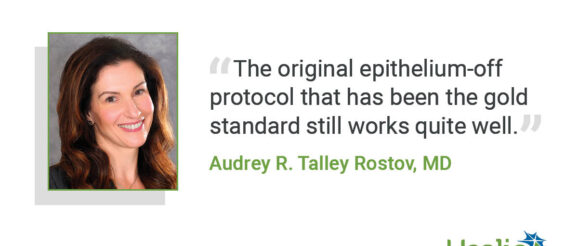What has been the most important innovation in corneal cross-linking?

Majmudar reports being a shareholder in CXL Ophthalmics. Talley Rostov reports being an investigator for Glaukos.
ADD TOPIC TO EMAIL ALERTS
ADDED TO EMAIL ALERTS
Click here to read the Cover Story, “Cross-linking advancements continue in US, Europe.”
Epithelium-on cross-linking
Cross-linking has been a major advance ever since I started doing it 10 to 15 years ago.
Hands down, the greatest innovation is something that has not been commercially realized, but I am hoping it becomes available in the next few years. That is the development of a true epithelium-on cross-linking.
Right now, the only cross-linking that is available in the United States is epithelium-off, in which the removal of the epithelium is critical to the success of the procedure. However, it also comes with more downtime for the patient and more risks, such as corneal scarring, haze and infection.
EpiSmart (CXL Ophthalmics) is a technology that I have had experience with since 2010, when it was in its earliest form. It has gone through multiple changes, but it has completed a phase 2 study, and we are gearing up for a phase 3 study after receiving new funding. The results have been nothing short of miraculous.
There are several advantages of this procedure. It has a quicker recovery, and you can do both eyes at the same time. It saves time for the doctor, the staff and for clinic flow. We have also seen some great outcomes in reduction of keratoconus progression, as well as improvements in patient visual acuity.
In the past, keratoconus was something that we would tolerate and then do a cornea transplant. Now, we want to be more proactive, prevent it from getting worse and help people see better.
Parag A. Majmudar, MD, is a Healio/OSN Board Member.
Tweaks to the procedure
Cross-linking honestly has not changed that much over the last 15 years. The original epithelium-off protocol that has been the gold standard still works quite well.
There have been all kinds of recipes that have tweaked the formula over the years. There have been different amounts of time, UV light pulse and UV light vs. increased energy and different ways to deliver the riboflavin. In the U.S., we are somewhat limited by what is FDA approved, and that is the Glaukos iLink system. It works well, but there are downsides, including discomfort and pain following the procedure.
Years ago, I was an investigator on an epi-on trial for CXL Ophthalmics that used a different formulation of riboflavin and pulsed UV light. Results of that trial were excellent.
Worldwide, people are able to use different systems that come with different riboflavin and UV light delivery devices. There are also differing results. Worldwide, epi-on has not been as efficacious as epi-off. However, you have to look at what riboflavin was used, how it was loaded and how the UV light was delivered.
Audrey R. Talley Rostov, MD, is an OSN Cataract Surgery Board Member.
ADDED TO EMAIL ALERTS
